Table of Contents
While some may be unaware of them, the British Coastline is home to one of the largest groups of organisms in the UK. The strandline is home to a variety of Bugs and Insects, almost invisible amongst seaweed and driftwood. While they feed on what has washed up, birds will feed on them.
Butterflies
Adonis Blue
Male adonis blues have vivid blue wings with white fringes that are chequered with black bars, while females are brown with orange spots. They are small butterflies, with wingspans of 38 mm.
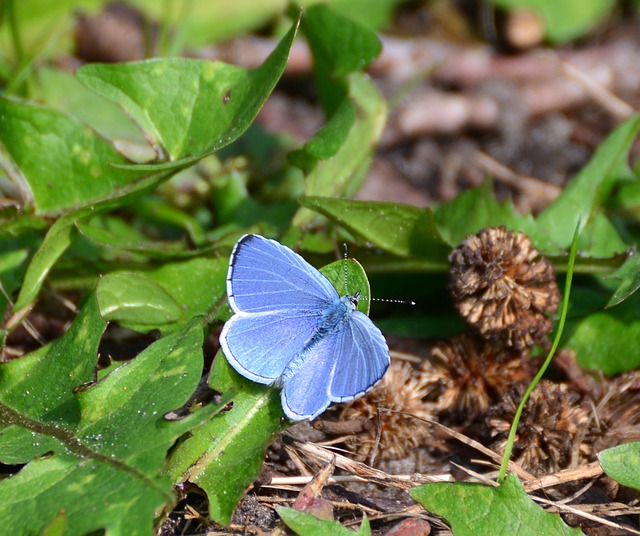
| Latin Name | Polyommatus bellargus |
| Larval type | Caterpillar – green and slug-like, with regular yellow markings and small black spots. |
| Diet | Caterpillars and adults feed largely on horseshoe vetch. |
| Best time to see | May to July. |
| Distribution | The adonis blue is largely restricted to southern England. |
| Habitat | Often found on the coast, the species can be seen in grassland habitats, particularly on warm, south-facing slopes. |
| Interesting fact: | Adonis blues have mutualistic relationships with some ant species, where the caterpillars produce sugary secretions for the ants to feed on. In turn, the ants bury the caterpillar once it forms a chrysalis and protect it from predators. |
Clouded Yellow
The clouded yellow is a medium-sized butterfly with an average wingspan of 60 mm. It has golden-yellow upperwings with dark edges, and yellowish-green underwings.

Photo: Marc Pascual
| Latin Name | Colias croceus |
| Larval type | Caterpillar – usually green with a yellowish-orange stripe down both sides of the body. |
| Diet | Caterpillars feed on leguminous plants such as clover and bird’s foot trefoil, whereas adults feed on the nectar of flowering plants. |
| Best time to see | June to August. |
| Distribution | Mainly found in the south of the UK, especially in Wales and southern England. |
| Habitat | Chalk downland and coastal grassland habitats are preferred. |
| Interesting fact: | Clouded yellows migrate to the UK from North Africa. In most years, only a few individuals arrive, but some years feature mass migrations numbering well into the thousands. |
Common Blue
Female common blues have brown upperwings with a hint of blue near the body. Males are bright blue with white fringes. Both sexes have average wingspans of 35 mm.
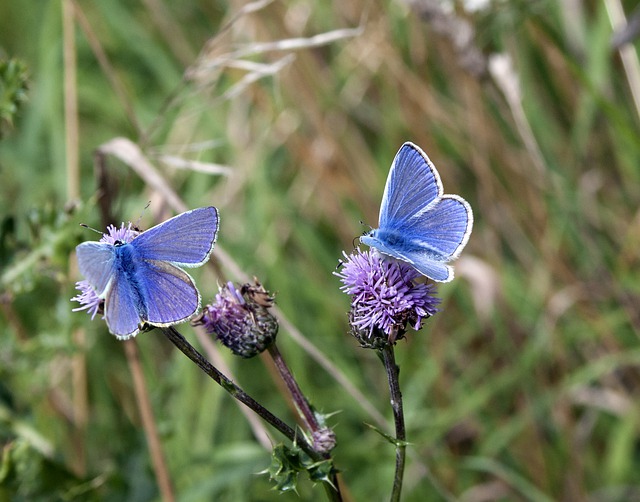
| Latin Name | Polyommatus icarus |
| Larval type | Caterpillar – green and slug-like, with a faint yellow line down the centre of the body. |
| Diet | Caterpillars feed on bird’s foot trefoil and clover, while adults consume the nectar from many types of wildflower. |
| Best time to see | August to October. |
| Distribution | Common blues can be found almost anywhere in the UK, but are most abundant in southern regions. |
| Habitat | Uses a wide range of habitats, including sand dunes, downland and woodland clearings. |
| Interesting fact: | Common blues usually appear in two separate generations during the year – one lasting from May to June and the other lasting from July to October. |
Dark Green Fritillary
The dark green fritillary is orange with black spots, but gets its name from the green hue on the underside of the hindwings. It has an average wingspan of 65 mm.
 Photo: Gilles San Martin from Namur, Belgium, CC BY-SA 2.0, via Wikimedia Commons
Photo: Gilles San Martin from Namur, Belgium, CC BY-SA 2.0, via Wikimedia Commons
| Latin Name | Speyeria aglaja |
| Larval type | Caterpillar – black in colour and covered in spines, with a series of orange spots down both sides. |
| Diet | The caterpillars feed on the leaves of violets, while the adults drink nectar from several flowering plants. |
| Best time to see | July to August. |
| Distribution | Dark green fritillaries can be found throughout the UK, although they are rarer in the east. |
| Habitat | Occurs in flower-rich habitats such as meadows, dunes, grassland and scrub. |
| Interesting fact: | Dark green fritillaries are powerful fliers, however they often stay very local to their breeding grounds. |
Dingy Skipper
The dingy skipper is a small butterfly, with an average wingspan of 29 mm. Its wings are light brown with pale fringes and mottled markings.
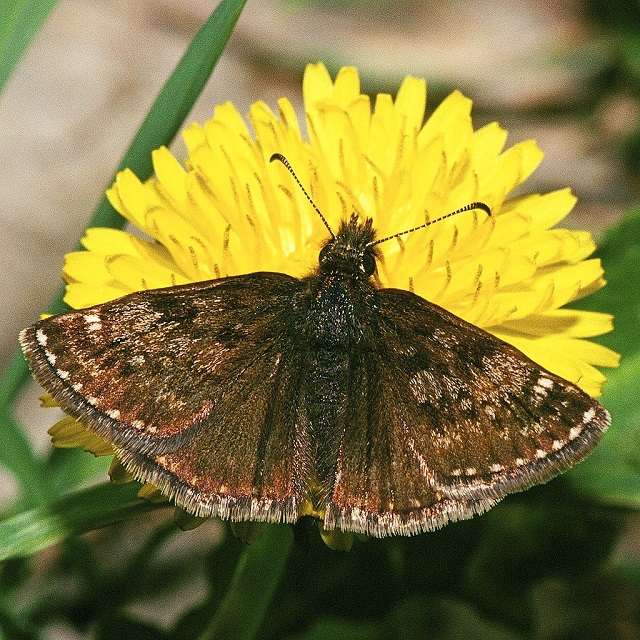
Olei, CC BY-SA 2.5, via Wikimedia Commons
| Latin Name | Erynnis tages |
| Larval type | Caterpillar – pale green in colour, with a prominent brown head. |
| Diet | Caterpillars feed mainly on bird’s foot trefoil, with adults drinking nectar from various wildflowers. |
| Best time to see | May to July. |
| Distribution | Mainly found in southern regions, with small populations in the north of Scotland. |
| Habitat | Dingy skippers prefer coastal habitats such as dunes and sea cliffs, as well as grassland. |
| Interesting fact: | Unlike other British butterflies, the dingy skipper likes to perch with its wings folded in a moth-like position, usually on dead flower-heads. |
Glanville Fritillary
Glanville fritillaries have black and orange chequered patterns on their upperwings, with cream and orange bands underneath. Their wingspans average 44 mm.
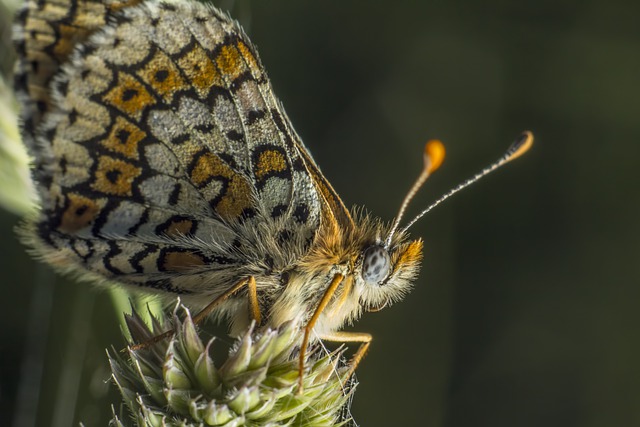
Photo: Erik Karits
| Latin Name | Melitaea cinxia |
| Larval type | Caterpillar – black in colour, with a brown head and a series of bristles. |
| Diet | Caterpillars usually feed on species of plantain, while adults prefer nectar from dandelions and other wildflowers. |
| Best time to see | May to June. |
| Distribution | Glanville fritillaries are restricted to southern England. |
| Habitat | Mainly found on the coast, this species favours river valleys and south-facing chalk downland. |
| Interesting fact: | The Glanville fritillary is named after the naturalist, Lady Eleanor Glanville, who discovered the species in the late 1600’s. |
Grayling Butterfly
Grayling butterflies are mainly mottled brown in colour, with a touch of orange on the hindwings. Their wingspans average 57 mm in width.
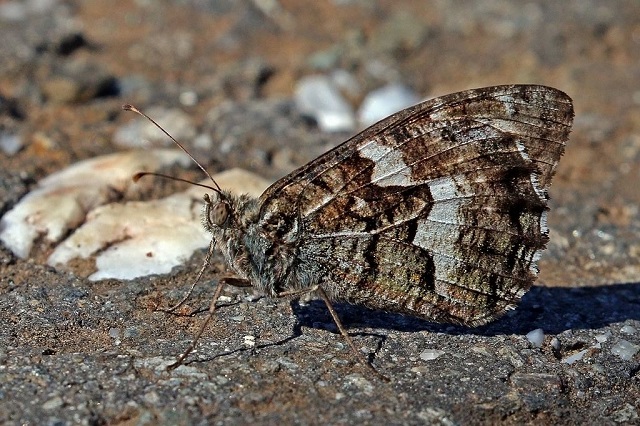
Photo: Charles J. Sharp, CC BY-SA 4.0, via Wikimedia Commons
| Latin Name | Hipparchia semele |
| Larval type | Caterpillar – light brown with darker stripes and a tail which tapers to two prongs. |
| Diet | Grayling caterpillars feed on grasses such as marram. Adults live on a diet of wildflower nectar. |
| Best time to see | July to September. |
| Distribution | Grayling butterflies can be found right around the UK, but are more common in western regions. |
| Habitat | Primarily a coastal species, the grayling lives in dune habitats, clifftops and saltmarsh. |
| Interesting fact: | The grayling is able to regulate its body temperature using its wings – an unusual ability for a butterfly. During cold periods, the species will often lean towards the sun to raise its body temperature. |
Large White
Large whites, true to their name, are large butterflies with wingspans averaging 65 mm. The wings of males are white with black tips, while females are similar but with four black spots.
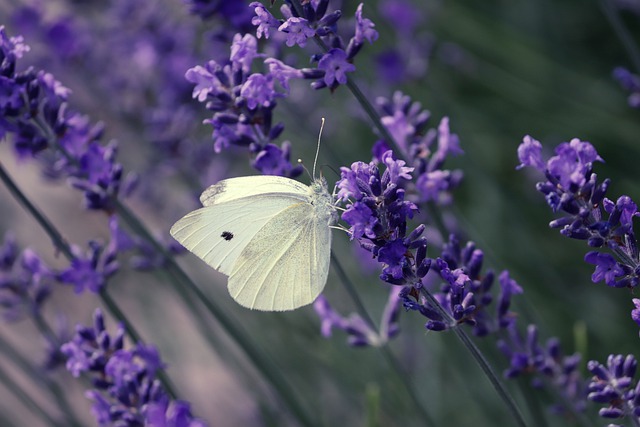
Photo: Manfred Richter
| Latin Name | Pieris brassicae |
| Larval type | Caterpillar – lime-green in colour with black patches and sparse hairs. |
| Diet | Caterpillars feed on plants of the cabbage family, while adults feed on flower nectar. |
| Best time to see | April to June. |
| Distribution | Large whites are common in large parts of the UK, with the exception of north-west Scotland. |
| Habitat | The species uses a wide range of habitats, including gardens, farmland and coastal grassland. |
| Interesting fact: | Large white caterpillars accumulate so many mustard oils from the plants they eat that they become poisonous to predators. |
Meadow Brown
The meadow brown is a dark brown butterfly with orange patches on its wings and black eye-spots. It has an average wingspan of 53 mm.
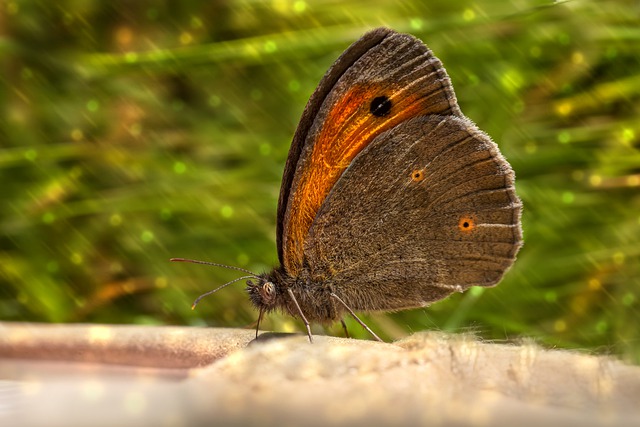
Photo: Erik Karits
| Latin Name | Maniola jurtina |
| Larval type | Caterpillar – green in colour with a squat, hairy body. |
| Diet | Caterpillars feed on various grasses, especially fescues. Adults prefer wildflower nectar. |
| Best time to see | June to September. |
| Distribution | Occurs right across the UK, although the species is less prevalent at higher altitudes. |
| Habitat | Meadow browns can be seen in various grassland habitats, as well as parks, woodland and seacliffs. |
| Interesting fact: | The meadow brown has a marked variation in appearance, depending on the region, with four separate subspecies being found across the UK. |
Northern Brown Argus
The northern brown argus is a small butterfly, with an average wingspan of 29 mm. It is dark brown in colour, with lines of orange spots towards the edge of the wings.
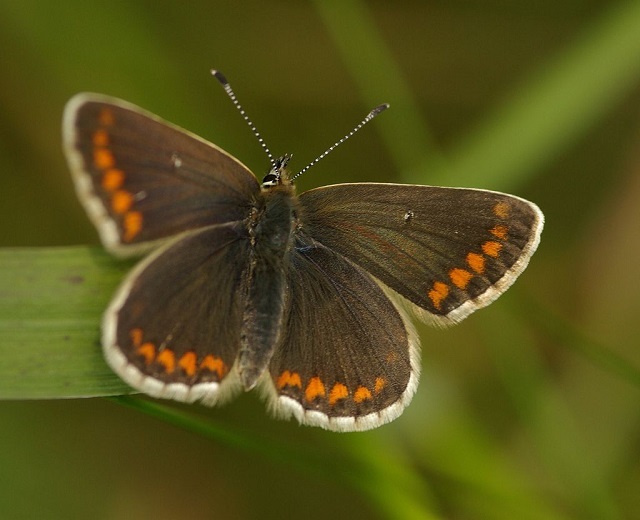
Velela, CC BY-SA 3.0, via Wikimedia Commons
| Latin Name | Aricia artaxerxes |
| Larval type | Caterpillar – green in colour, with a hairy body and a pale stripe down each side. |
| Diet | Caterpillars feed mainly on common rock-rose, while adults consume flower nectar. |
| Best time to see | June to July. |
| Distribution | The northern brown argus can be found in northern England and parts of Scotland. |
| Habitat | Prefers sheltered grasslands, coastal valleys and dune systems, often in well-drained areas. |
| Interesting fact: | The northern brown argus is very similar in appearance to the more common brown argus and was considered to be a subspecies of this butterfly for many years, until it was recently re-classified. |
Painted Lady
Painted ladies are medium-sized, with average wingspans of 53 mm. They are mainly orange, with black wingtips and black and white spots.
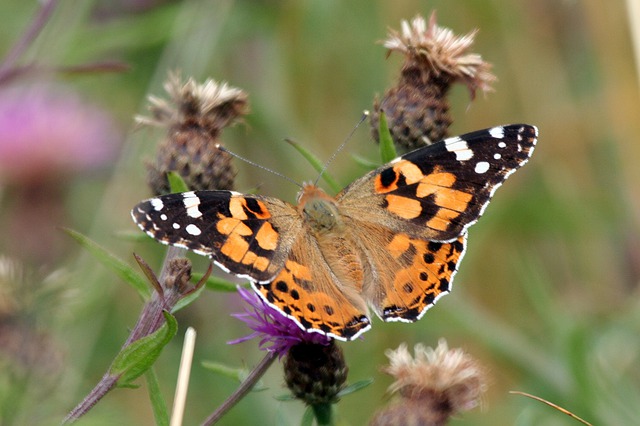
Photo: Ian Lindsay
| Latin Name | Vanessa cardui |
| Larval type | Caterpillar – usually black in colour with spines that can be dark or orange. |
| Diet | Caterpillars often feed on thistles and nettles, while adults choose buddleia and other flowers. |
| Best time to see | April to June. |
| Distribution | Widespread in England and Wales, but less common elsewhere. |
| Habitat | Painted ladies prefer open habitats such as grasslands, meadows and coastal regions. |
| Interesting fact: | Painted ladies migrate over long distances, sometimes arriving in the UK in huge numbers during summer. |
Peacock
The peacock is easily recognisable by its reddish-orange colour and four large eyespots, which are tinged with yellow and blue. It is a medium-to-large species, with a wingspan of 66 mm.
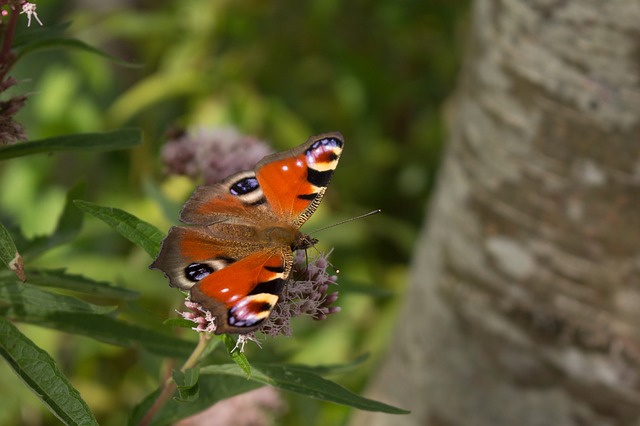
Photo: Jan Birdie
| Latin Name | glais io |
| Larval type | Caterpillar – black with small white spots and very large spikes. |
| Diet | Nettles are the main food source for caterpillars, whereas adults feed on nectar from flowers such as buddleia. |
| Best time to see | August to October. |
| Distribution | The peacock is very widespread in the UK, found almost everywhere except some of the western isles of Scotland. |
| Habitat | Present anywhere with flowering plants, including gardens, woodland, coastal cliffs and dunes. |
| Interesting fact: | The peacock’s large eyespots are an anti-predator defence mechanism, designed to mimic the eyes of larger animals and dissuade a predator from attacking. |
Red Admiral
The red admiral is mainly black with reddish-orange stripes on its wings. The wingtips have large white spots. The species is large, with a wingspan of 70 mm.
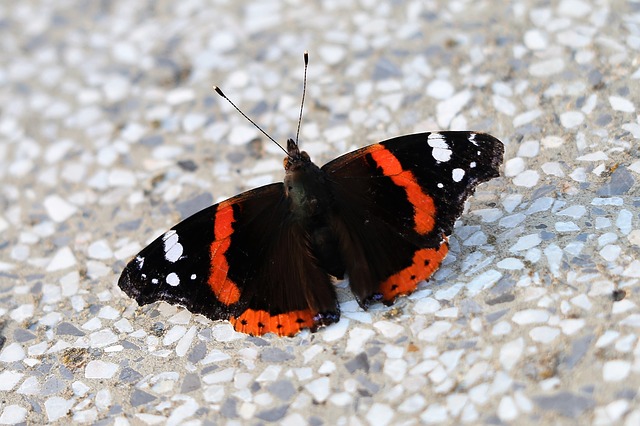
Photo: Goran Horvat
| Latin Name | Vanessa atalanta |
| Larval type | Caterpillar – mainly black in colour with yellow and black spines. |
| Diet | Caterpillars feed mostly on nettles. Adults sip nectar from flowering plants such as buddleia and feed on overripe fruit. |
| Best time to see | June to August. |
| Distribution | Red admirals can be found right across the country, but are less common in northern regions. |
| Habitat | Common visitors to gardens, grasslands and coastal areas. |
| Interesting fact: | Red admiral caterpillars construct protective tents from the leaves of nettles, using a silk-like substance to stitch the leaves together. |
Small Blue
With a wingspan of around 25 mm, the small blue is the smallest British butterfly. Despite its name, its wings are mainly brown with only a dusting of blue.
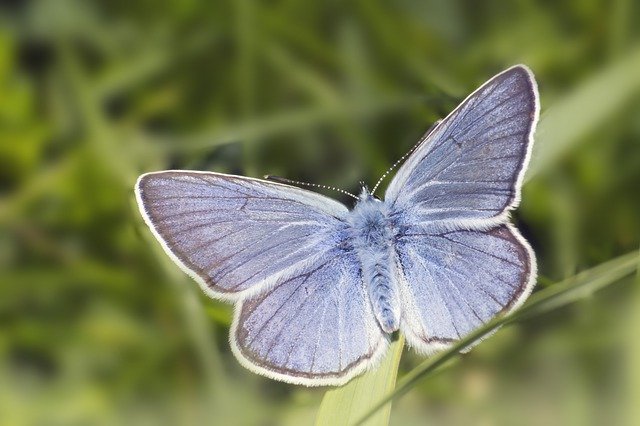
Photo: Erik Karits
| Latin Name | Cupido minimus |
| Larval type | Caterpillar – small and pale brown, with a body that is almost grub-like. |
| Diet | The caterpillars feed solely on the anthers of the kidney vetch, while the adults feed on flower nectar and dung. |
| Best time to see | May to June. |
| Distribution | The small blue occurs patchily, mainly on the south coast of England and Wales, and the north coast of Scotland. |
| Habitat | Sheltered grassland is preferred, especially near dunes or in areas of chalk and limestone. |
| Interesting fact: | Small blues live in colonies which can be found roosting in long grass overnight. Usually, these colonies number around 30 individuals, although some consist of thousands. |
Small Copper
Hence its name, the small copper is a small butterfly species, with an average wingspan of 34 mm. It has orange upperwings with dark brown spots and dark margins.
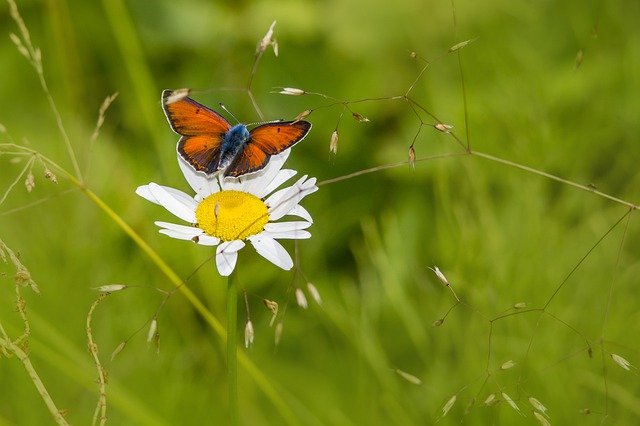
Photo: Erik Karits
| Latin Name | Lycaena phlaeas |
| Larval type | Caterpillar – usually small and green, occasionally with pinkish fringes. |
| Diet | Caterpillars mostly feed on sorrel, while adults can be seen feeding on ragwort and thistles. |
| Best time to see | May to October. |
| Distribution | Small coppers are found throughout the UK, but are seen in greater numbers in southern regions. |
| Habitat | Often found in chalk grassland, heathland and woodland, especially in dry areas. |
| Interesting fact: | Male small coppers are very territorial creatures and will aggressively chase other insects away from their preferred spots. |
Moths
Barrett’s Marbled Coronet
Barrett’s marbled coronet has a wingspan of around 38 mm and is variable in colour, usually with a mosaic pattern of browns or greys.
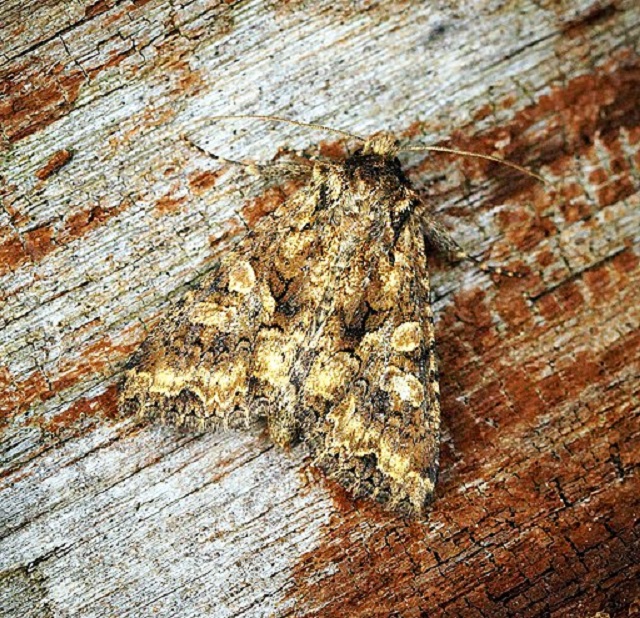
Photo: Ben Sale from UK, CC BY 2.0, via Wikimedia Commons
| Latin Name | Conisania andalusica |
| Larval type | Caterpillar |
| Diet | Coastal plants such as sea campion are preferred by caterpillars. Adults feed on fruits, sap or nectar. |
| Best time to see | June to July. |
| Distribution | Mainly concentrated in south-west areas of the UK, particularly the south of England. |
| Habitat | A coastal species, Barrett's marbled coronet can be found on clifftops and shingle beaches. |
| Interesting fact: | The caterpillars of this moth feed inside the roots of their host plants, where they eventually form cocoons to survive the cold winter months. Belted Beauty |
Belted Beauty
Female belted beauties are wingless, but males are dark with prominent white stripes across their wings. They have an average wingspan of 29 mm.
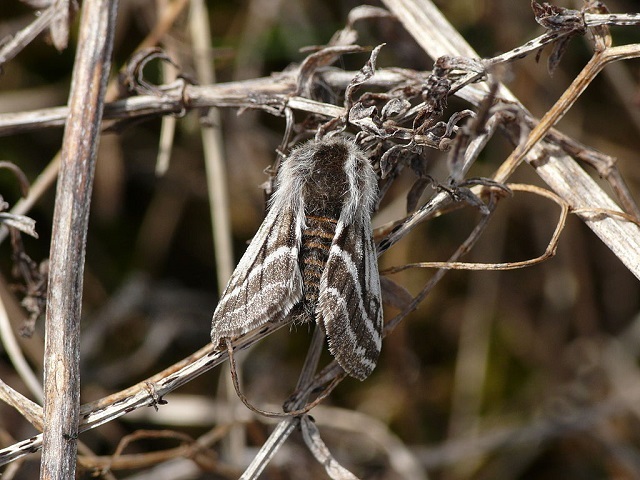
Photo by Harald Süpfle, CC BY-SA 3.0, via Wikimedia Commons
| Latin Name | Lycia zonaria |
| Larval type | Caterpillar – pale green with yellow stripes down each side of the body. |
| Diet | Bird’s foot trefoil and kidney vetch are the main foods for caterpillars. Adults feed on nectar. |
| Best time to see | March to April. |
| Distribution | Can be found locally in north Wales, north-west England and western Scotland. |
| Habitat | Belted beauties can be seen in areas of saltmarsh, sand dunes and machair. |
| Interesting fact: | As female belted beauties cannot fly, they crawl to elevated positions to attract a mate, often being seen at the top of fence posts. |
Brown-tail
Brown-tail moths are snow-white in colour, with fluffy bodies and distinct brown tips to the abdomen. Their average wingspan is 39 mm.
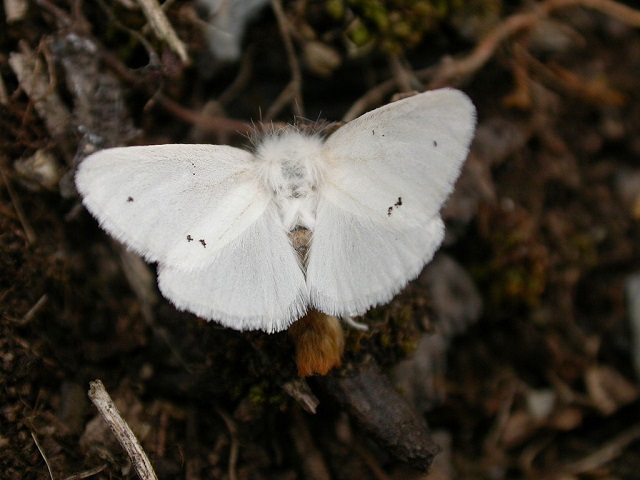
Photo by Donald Hobern from Canberra, Australia, CC BY 2.0, via Wikimedia Commons
| Latin Name | Euproctis chrysorrhoea |
| Larval type | Caterpillar – brown with white patches, two bright orange spots near the tail and hairy bodies. |
| Diet | Caterpillars feed on hawthorn, brambles and fruit trees. Adults prefer nectar and fruits. |
| Best time to see | July to August. |
| Distribution | Brown-tail moths are mainly found in south-east England, with smaller populations in Wales and more northerly regions. |
| Habitat | Often seen near the coast, in areas of scrubland and hedgerow. |
| Interesting fact: | The hairs of brown-tail caterpillars are extremely irritating to human skin, causing itchy rashes that can last for weeks at a time. |
Chalk Carpet
The chalk carpet moth is a medium-sized species with a wingspan of 35 mm. It is usually grey in colour, with muted brown lines and dark spots.

Photo by Dumi, CC BY-SA 3.0, via Wikimedia Commons
| Latin Name | Scotopteryx bipunctaria |
| Larval type | Caterpillar – usually pale grey with light vertical stripes. |
| Diet | Bird’s foot trefoil and clover are the main foods for caterpillars. |
| Best time to see | July to August. |
| Distribution | Chalk carpet moths are most abundant in southern England and Wales, with some being found further north. |
| Habitat | Often seen on chalk downland and limestone hills, especially near the coast. |
| Interesting fact: | This moth species regularly basks on bare patches of chalk and is readily disturbed during the day, also choosing to fly at night. |
Cinnabar moth
Cinnabar moths are easily distinguished by having bright red and black wings, with two red dots on each. Their wingspans average 40 mm.
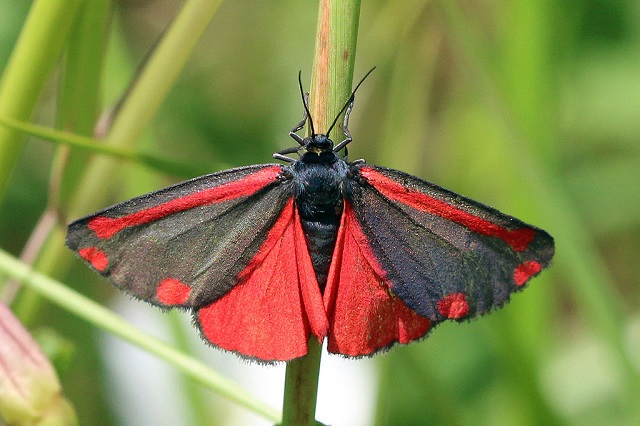
Photo by Charles J. Sharp, CC BY-SA 4.0, via Wikimedia Commons
| Latin Name | Tyria jacobaeae |
| Larval type | Caterpillar – large with prominent black and orange horizontal stripes. |
| Diet | Ragwort and similar plants are favoured by the caterpillars. Adults drink nectar from flowers. |
| Best time to see | May to July. |
| Distribution | Widespread in the UK, but most common in southern regions. |
| Habitat | Cinnabar moths can be found in open grassland habitats, sand dunes and heathland. |
| Interesting fact: | The bright colours of cinnabar caterpillars signify that they have a very unpleasant taste, which they gain from the plants they feed on. Most potential predators therefore choose to avoid them. |
Convolvulus Hawk-moth
Convolvulus hawk-moths have large bodies and thick antennae. Their wingspans average 100 mm and they are generally grey in colour, with pink and black bands on the abdomen.
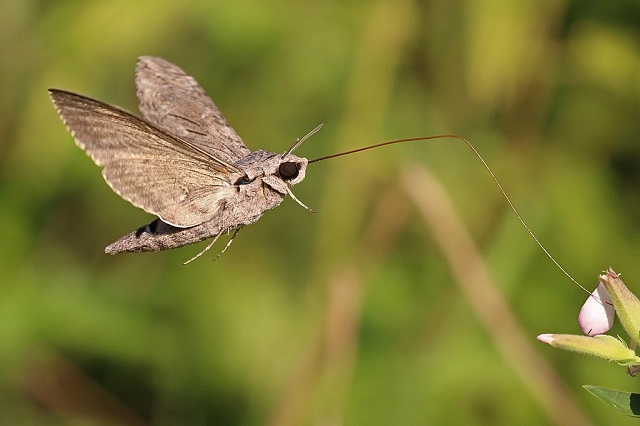
Photo by Charles J. Sharp, CC BY-SA 4.0, via Wikimedia Commons
| Latin Name | Agrius convolvuli |
| Larval type | Caterpillar – very large, with a prominent spike at the tail-end. Usually green in colour with orange spots. |
| Diet | Bindweed is the most common food for caterpillars, whereas adults visit a variety of flowers to feed on nectar. |
| Best time to see | August to November. |
| Distribution | Usually found in south-east England, although they sometimes range as far north as Scotland. |
| Habitat | onvolvulus hawk-moths are most often seen in gardens or coastal meadows. |
| Interesting fact: | This species is unable to withstand the cold winter temperatures in the UK, and only migrates to British shores from Africa during summer. |
Cream-spot Tiger
A colourful species, the cream-spot tiger has orange underwings and black forewings which are speckled with white spots. It has a wingspan of 52 mm.
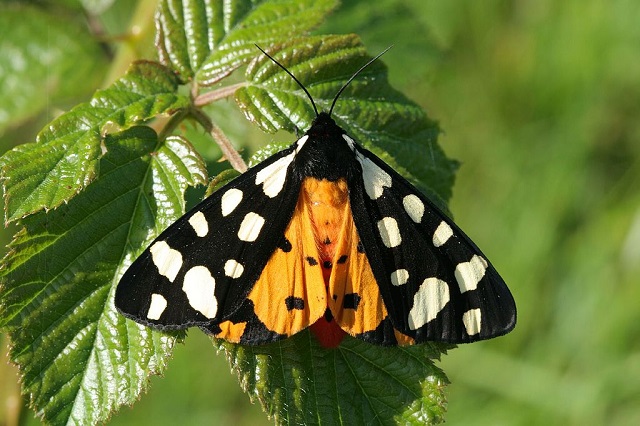
Photo by Danny Chapman, CC BY 2.0, via Wikimedia Commons
| Latin Name | Epicallia villica |
| Larval type | Caterpillar – darkly coloured, with hairy bodies and red feet. |
| Diet | A range of herbaceous plants are eaten by caterpillars, while adults feed on nectar. |
| Best time to see | May to July. |
| Distribution | Cream-spot tigers are largely found in southern England and Wales. |
| Habitat | Often seen near the coast in habitats such as clifftops, sand dunes and saltmarsh. They prefer open areas. |
| Interesting fact: | When disturbed, cream-spot tigers flash their orange wings in order to warn off potential predators. |
Garden Tiger
Garden tiger moths have orange hindwings with black spots, and front wings that are brown and white. They have an average wingspan of 59 mm.
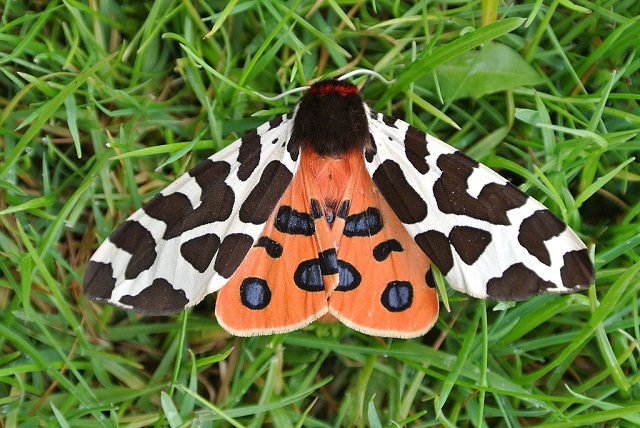
Photo by Temple of Mara, CC BY-SA 3.0, via Wikimedia Commons
| Latin Name | Arctia caja |
| Larval type | Caterpillar – large and brown in colour, with a very hairy body. |
| Diet | Nettles and dock plants make up most of the caterpillar’s diet. Adults feed on flower nectar. |
| Best time to see | July to August. |
| Distribution | Common in much of the UK, but found in larger numbers in the south-east. |
| Habitat | Open habitats are preferred by the garden tiger, including sand dunes, meadows and gardens. |
| Interesting fact: | Garden tiger caterpillars are affectionately known as “woolly bears” due to their dense hair. This hair can be very irritating to other animals and helps to protect the caterpillar from being eaten. |
Ground Lackey
The ground lackey is pale brown or yellowish in colour, with light bands. It has an average wingspan of 36 mm.
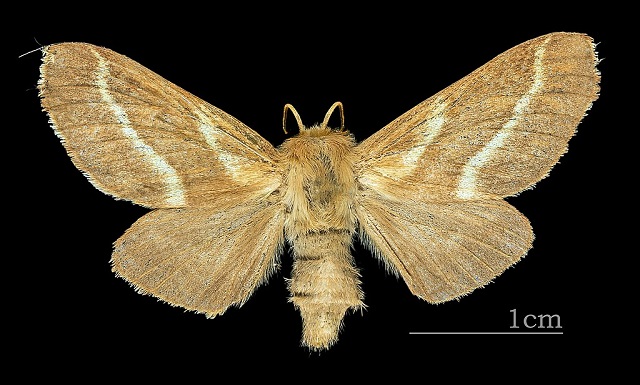
Photo: Muséum de Toulouse, CC BY-SA 4.0, via Wikimedia Commons
| Latin Name | Malacosoma castrensis |
| Larval type | Caterpillar – often vibrant blue with dark streaks and orange hairs. |
| Diet | Caterpillars feed on a range of coastal plants such as sea plantain. |
| Best time to see | July to August. |
| Distribution | Restricted to areas of south-east England, mainly in coastal counties. |
| Habitat | Ground lackeys are usually seen around areas of saltmarsh and shingle beaches, along with heathland. |
| Interesting fact: | Adult ground lackeys are unable to feed and only live for a few weeks as a result, time which they use solely for finding a mate and breeding. |
Hummingbird Hawk-moth
Hummingbird hawk-moths have brown forewings and orange hindwings, with black and white abdomens. Their wingspans average 58 mm.

Photo: Erik Karits
| Latin Name | Macroglossum stellatarum |
| Larval type | Caterpillar – large and usually green, with yellow vertical stripes and a prominent tail spike. |
| Diet | Bedstraw is the main food of the caterpillar, with adults drinking nectar from various flowering plants. |
| Best time to see | May to September. |
| Distribution | Hummingbird hawk-moths are widespread in the UK, but are most common in southern England and Wales. |
| Habitat | Coastal areas, gardens and meadows are preferred, although many habitats are used. |
| Interesting fact: | The hummingbird hawk-moth – much like the true hummingbirds – hovers close to tube-shaped flowers and uses its long proboscis to reach the nectar within. |
Sand dart
The sand dart is a medium-sized moth, with a wingspan of 37 mm. Its forewings are usually rufous brown with dark markings, while its hindwings are pale.
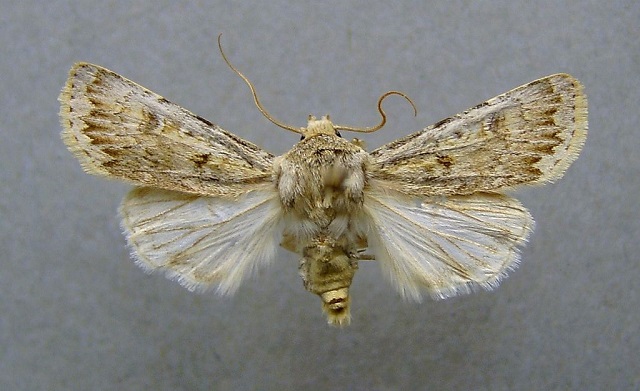
Photo Dumi, CC BY-SA 3.0, via Wikimedia Commons
| Latin Name | Agrotis ripae |
| Larval type | Caterpillar – sand-coloured and small, with a slightly darker head. |
| Diet | Coastal plants such as sea rocket are consumed by the caterpillars. |
| Best time to see | June to July. |
| Distribution | Sand darts are mainly found in the south of the UK, but small populations can be found in eastern Scotland. |
| Habitat | Primarily a coastal species, the sand dart resides in sand dunes. |
| Interesting fact: | The caterpillars bury themselves into the sand during the day in order to avoid predators. At night, they come out to feed. |
Silver Y
The Silver Y moth is named after the two silvery Y-shaped marks that appear on its forewings. The wings themselves are coloured a mixture of browns and the wingspan of the species averages 37 mm.
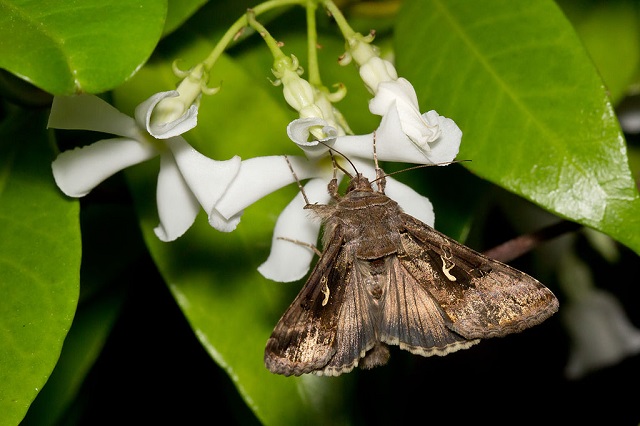
Photo: Carlos Delgado, CC BY-SA 3.0, via Wikimedia Commons
| Latin Name | Autographa gamma |
| Larval type | Caterpillar – generally green in colour, though some may have a whitish stripe down each side. |
| Diet | Caterpillars feed on a diverse range of low-growing plants. The adults feed on nectar. |
| Best time to see | July to September. |
| Distribution | Silver Y moths can be found right across the UK, though are less common in the far north. |
| Habitat | Prefers open habitats such as coastal grasslands and clifftops, but will also visit gardens. |
| Interesting fact: | The silver Y moth is a migrant to the UK, arriving from more southerthy latitudes during the summer months, sometimes doing so in groups of thousands at a time. |
Six-spot Burnet
The six-spot burnet is a black moth with large antennae and six red spots on each wing. Its wingspan measures 34 mm on average.

Photo: Richard Barnard
| Latin Name | Zygaena filipendulae |
| Larval type | Caterpillar – yellowish-green in colour with black markings. |
| Diet | Bird’s foot trefoil is the main food for caterpillars, while adults prefer nectar. |
| Best time to see | June to August. |
| Distribution | Six-spot burnets are common throughout the UK, especially in southern England and Wales. |
| Habitat | Often seen on clifftops, sand dunes and grasslands, mainly on the coast. |
| Interesting fact: | Six-spot burnets emit a poisonous liquid containing cyanide when attacked, a tactic which helps to protect them from birds and lizards. |
Thrift Clearwing
The thrift clearwing has a narrow body and thin wings, with a wingspan of 14 mm. It is dark brown with white patches on the wings and white bars on the abdomen.

Photo: José Biedma López, GPL, via Wikimedia Commons
| Latin Name | Pyropteron muscaeforme |
| Larval type | Caterpillar – small and pale green, with a brown head. |
| Diet | Caterpillars and adults feed largely on thrift. |
| Best time to see | June to July. |
| Distribution | Thrift clearwings are found mainly in western parts of England and Wales, as well as scattered regions of Scotland. |
| Habitat | Usually resides on rocky coastlines and sea cliffs. |
| Interesting fact: | Thrift clearwing larvae survive the winter by feeding on the roots and crowns of their host plant, usually emerging as adults in late May. |
Yellow Shell
Yellow shells are small moths with wingspans of 23 mm. They are variable in colour, but are most often seen with yellow wings that are broken up by dark markings or pale lines.
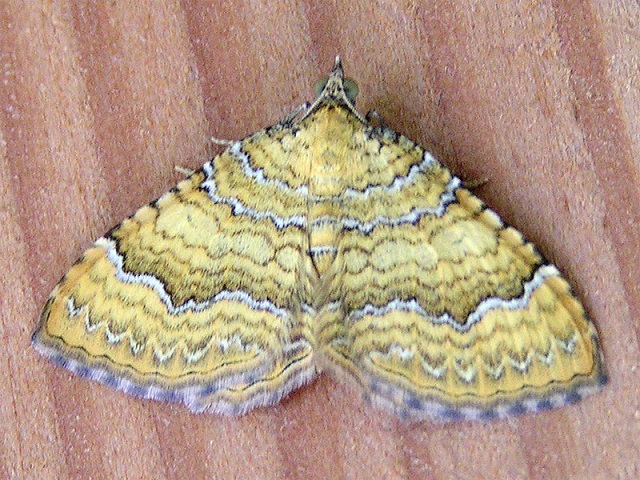
Eric Steinert, CC BY-SA 3.0, via Wikimedia Commons
| Latin Name | Camptogramma bilineata |
| Larval type | Caterpillar – thin bodied with a green, semi-translucent colour. |
| Diet | Caterpillars feed largely on low-growing plants such as sorrel. |
| Best time to see | June to August. |
| Distribution | Yellow shells are found right across the UK, although they avoid upland areas. |
| Habitat | Usually seen in lowland habitats such as woodland, hedgerows and meadows. |
| Interesting fact: | Yellow shells vary in colour depending on geographical location, with individuals in Scotland and Northern Ireland being noticeably darker. |
Beetles
Common Sexton Beetle
The common sexton beetle is a relatively large beetle species, measuring 30 mm in length. Its body is mainly black, with bright orange patches.

Photo: Harald Matern
| Latin Name | Nicrophorus vespilloides |
| Larval type | Grub – white or pale brown, with orange markings. |
| Diet | Mainly the carcasses of larger animals such as birds and mammals. |
| Best time to see | April to October. |
| Distribution | Common sexton beetles can be found almost everywhere in the UK. |
| Habitat | Often seen among coastal grassland and heath, as well as woodland areas and gardens. |
| Interesting fact: | Common sexton beetles detect rotting corpses using receptors on their antennae, which are sensitive enough to pick up scents from more than a kilometre away. |
Dune Chafer
The dune chafer is a rounded beetle which is variable in colour, although is often seen with a brown abdomen and a green head. It averages 13 mm in length.
 Photo: © W. Funk
Photo: © W. Funk
| Latin Name | Anomala dubia |
| Larval type | Grub |
| Diet | Largely made up of the leaves of flowering plants. |
| Best time to see | May to August. |
| Distribution | Dune chafer populations are mainly concentrated in southern Wales and south-east England, with some also found further north. |
| Habitat | Primarily a coastal species, the dune chafer prefers sand dunes or clay soils. |
| Interesting fact: | Female dune chafers dig down into sandy areas to lay their eggs in several batches. The larvae develop underground for most of the year, before emerging as beetles in late spring. |
Green Tiger Beetle
The green tiger beetle is a large beetle, averaging 13 mm in length. It is metallic green in colour with an iridescent sheen and yellow spots.
 Photo: © W. Funk
Photo: © W. Funk
| Latin Name | Cicindela campestris |
| Larval type | Grub – pale in colour with a dark head and large mandibles. |
| Diet | Small invertebrates such as spiders, ants and caterpillars. |
| Best time to see | April to September. |
| Distribution | Green tiger beetles can be found throughout the UK, with the exception of some Scottish islands. |
| Habitat | Prefers well-drained habitats such as coastal grassland, sand dunes and heath. |
| Interesting fact: | Green tiger beetles are agile predators with long legs that allow them to run at speeds of 60 cm per second. Their large eyes make them adept at locating prey. |
Northern Dune Tiger Beetle
The northern dune tiger beetle has a narrow body with an average length of 14 mm. It is usually reddish-brown with bright yellow markings.
 Photo: © W. Funk
Photo: © W. Funk
| Latin Name | Cicindela hybrida |
| Larval type | Grub – pale in colour, with a dark head and large mandibles. |
| Diet | Mostly smaller insects and spiders. |
| Best time to see | May to August. |
| Distribution | Mainly found in western England, with scattered populations in the south. |
| Habitat | Northern dune tiger beetles favour coastal habitats such as dunes and heathland. |
| Interesting fact: | The northern dune tiger beetle favours warm conditions and will only emerge from its sandy burrow when the temperature climbs above 19°C. Once outside, it can thermoregulate by raising and lowering its body. |
Paederus littoralis
This species of beetle has a thin body with orange and black horizontal stripes. It averages 8 mm in length.
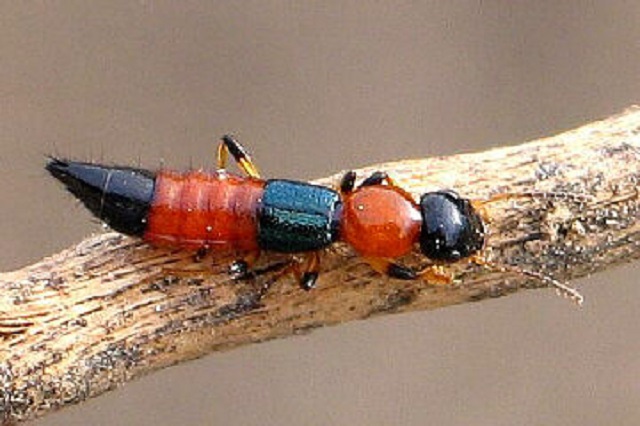 Photo: © W. Funk
Photo: © W. Funk
| Latin Name | Paederus littoralis |
| Larval type | pale brown with darker markings. |
| Diet | Mainly small insects, as well as their larvae and eggs. |
| Best time to see | May to August. |
| Distribution | Paederus littoralis is common across England and Wales, but only occurs locally further north. |
| Habitat | Coastal dunes and cliffs are preferred, although it can also be seen in dry grassland. |
| Interesting fact: | When disturbed, Paederus littoralis raises its abdomen in a threatening posture and will sometimes secrete a defensive fluid which is irritating to the skin. |
Phylan gibbus
This species is a small beetle, usually measuring around 8 mm in length. It is uniformly black, with a brownish tinge.

Photo: Janet Graham via https://www.flickr.com
| Latin Name | Phylan gibbus |
| Larval type | Grub |
| Diet | Mainly dead and decaying vegetation, although live plants will also be eaten. |
| Best time to see | May to August. |
| Distribution | Largely found in England and Wales, especially in southern regions. |
| Habitat | Phylan gibbus is mainly found on sandy or gravel beaches. |
| Interesting fact: | This species is a nocturnal beetle and spends most of the night foraging for food among seaweed and coastal plants, before sheltering during the day. |
Seven-spot Ladybird
The seven-spot ladybird has a black head and a reddish-orange abdomen, with seven black spots. It is a small beetle, measuring 9 mm.
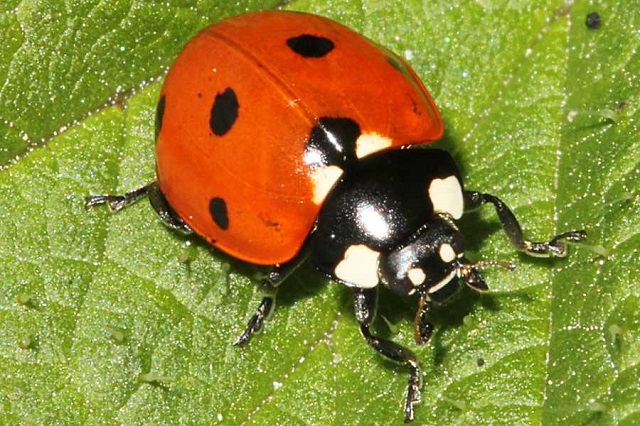
Photo: © W. Funk
| Latin Name | Coccinella septempunctata |
| Larval type | Grub – rather large and bluish-grey in colour, with orange patches. |
| Diet | March to October. |
| Best time to see | May to July. |
| Distribution | The seven-spot ladybird is widespread in the UK, with the exception of some parts of north-west Scotland. |
| Habitat | Uses many different habitats, including woodland, grassland and coastal cliffs and dunes. |
| Interesting fact: | When threatened, seven-spot ladybirds will often play dead and secret a foul-smelling liquid from their leg joints – a tactic that deters many predators. |
Shore Sexton Beetle
The shore sexton beetle is a large species, measuring 22 mm in length on average. Its body is black and the ends of its antennae are reddish-orange.
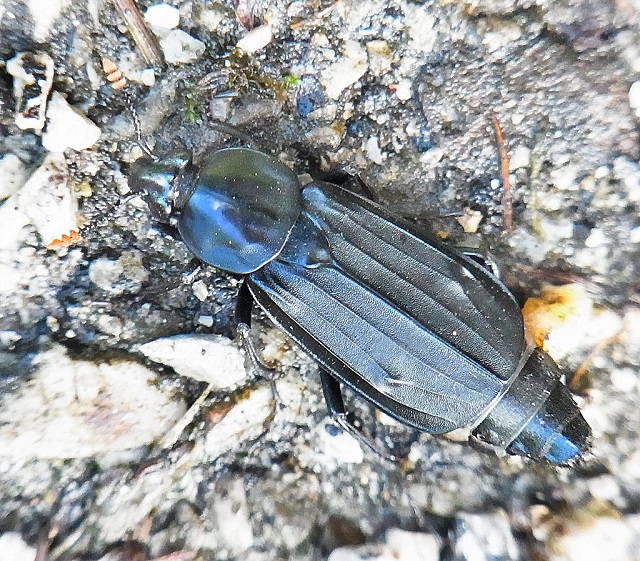
Photo: Siga, CC BY-SA 3.0, via Wikimedia Commons
| Latin Name | Necrodes littoralis |
| Larval type | Grub – pale in colour, with a maggot-like body. |
| Diet | Feeds mainly on carrion and other decaying matter. |
| Best time to see | April to September. |
| Distribution | Shore sexton beetles are most common in southern England and Wales, although scattered populations are found further north. |
| Habitat | Predominantly a coastal species, seen on sandy shores, open heathland and wooded areas. |
| Interesting fact: | Shore sexton beetles usually lay their eggs in the soil beneath dead carcasses. Once the eggs hatch, the parents chew up pieces of food and feed them to the developing larvae. |
Sulphur Beetle
The sulphur beetle gets its name from its bright yellow colouration, which makes it easily distinguishable from other beetle species. It has an average length of 7 mm.
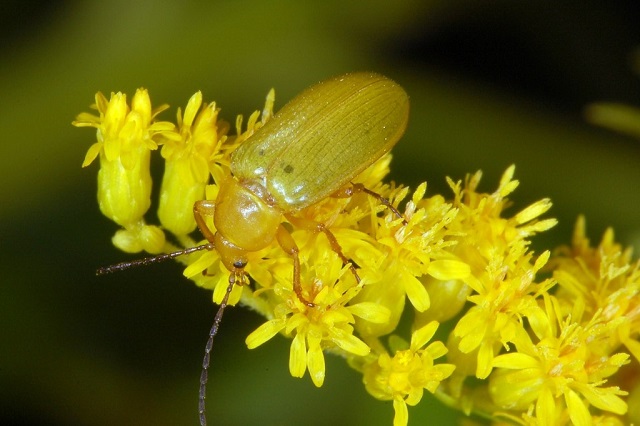
Fritz Geller-Grimm, CC BY-SA 3.0, via Wikimedia Commons
| Latin Name | Cteniopus sulphureus |
| Larval type | Grub |
| Diet | Feeds on the nectar and pollen produced by flowers. |
| Best time to see | April to August. |
| Distribution | Largely restricted to the south of England. |
| Habitat | Sulphur beetles prefer warm, dry regions such as chalk grassland and coastal sand dunes. |
| Interesting fact: | Being thermophilic creatures, sulphur beetles are adapted to favour warm, sunny conditions. For this reason, they are more likely to be seen on sunny days. |
Staphylinus erythropterus
This beetle species has a black abdomen and forebody, with an orange thorax. It is a narrow beetle, with a length of 16 mm.

Photo: Udo Schmidt from Deutschland, CC BY-SA 2.0, via Wikimedia Commons
| Latin Name | Staphylinus erythropterus |
| Larval type | Grub |
| Diet | Mostly decaying plant material, but also dung and carrion. |
| Best time to see | April to June |
| Distribution | Common throughout Wales and Scotland, being found more sporadically in England. |
| Habitat | Staphylinus erythropterus is often seen on sandy soils, in areas of meadow and patchy vegetation. |
| Interesting fact: | Adults of Staphylinus erythropterus are often active on bright, sunny days. At other times, they tend to shelter under stones and logs, particularly in damp areas. |
Flies
Emerald Damselfly
The emerald damselfly is a large damselfly species, measuring 38 mm in length. Both sexes are metallic green, although males tend to have a bluish tinge.
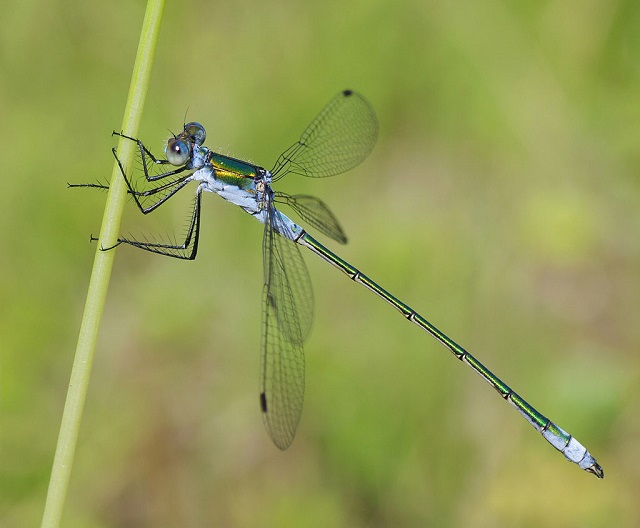
Photo: Christian Fischer, CC BY-SA 3.0, via Wikimedia Commons
| Latin Name | Lestes sponsa |
| Larval type | Nymph – smaller and browner than the adult, with a splayed tail-end. |
| Diet | Adults primarily eat flying insects, while larvae feed on aquatic insects and crustaceans. |
| Best time to see | June to August. |
| Distribution | Found right across the UK but less common in upland regions. |
| Habitat | Emerald damselflies can be seen around shallow, freshwater habitats with lots of vegetation. |
| Interesting fact: | Unlike other damselfly species – which rest with their wings closed – the emerald damselfly holds its wings open at a 45 degree angle. This gives it an alternative name, the common spreadwing. |
Hairy Dragonfly
Hairy dragonflies, true to their name, are covered in small hairs. They are mainly black in colour, although the males have a range of blue and green markings, while females have yellow markings. They measure 55 mm in length.
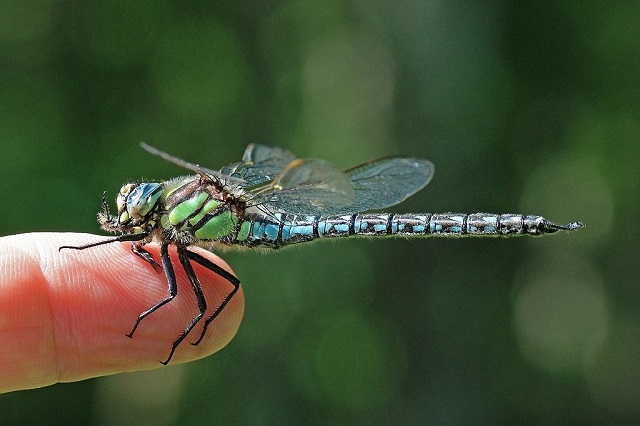
Photo: Charles J. Sharp, CC BY-SA 4.0, via Wikimedia Commons
| Latin Name | Brachytron pratense |
| Larval type | Nymph – stocky and large, with a dark brown colour. |
| Diet | Adults mainly feed on other flying insects, while larvae eat aquatic insects and small fish. |
| Best time to see | May to June. |
| Distribution | Hairy dragonflies are mainly concentrated in south-east England and south Wales, although there are small populations in western Scotland. |
| Habitat | Prefers still, freshwater habitats with abundant vegetation, such as wetlands. |
| Interesting fact: | The hairy dragonfly is incredibly agile on the wing, but only chooses to fly while the sun is out. As soon as the sun disappears, the dragonfly finds a place to perch and wait. |
Kelp Fly
The kelp fly is a small species of fly, with an average length of 6 mm. It has a dark brown to black body and a set of translucent wings.

Photo: S. Rae from Scotland, UK, CC BY 2.0, via Wikimedia Commons
| Latin Name | Coelopa frigida |
| Larval type | Maggot |
| Diet | Mainly seaweed and other forms of marine algae. |
| Best time to see | May to August. |
| Distribution | Common right around the UK coast, especially in western regions. |
| Habitat | Kelp flies are found on a wide range of shorelines, including rocky coasts and sandy beaches. |
| Interesting fact: | Climate change is greatly increasing the number of kelp flies, so much so that they sometimes emerge as large blooms – creating a pest problem for beach-goers. |
Large Red Damselfly
The large red damselfly is mainly red in colour, with black markings and black legs. It measures 35 mm in length.
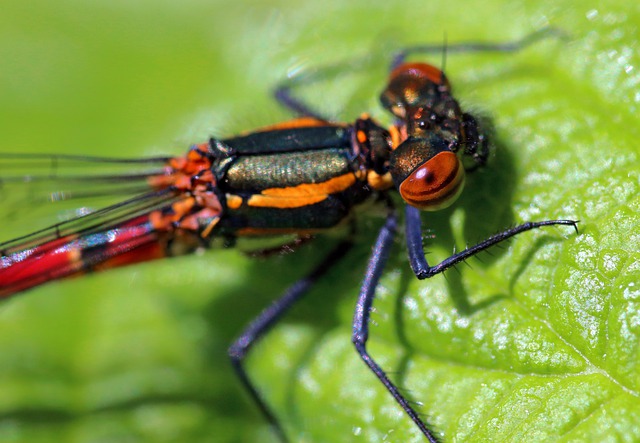
Photo: Emphyrio on Pixabay
| Latin Name | Pyrrhosoma nymphula |
| Larval type | Nymph – short and mottled brown, with a splayed tail-end. |
| Diet | Adults feed on flying insects, while larvae eat aquatic insects and small crustaceans. |
| Best time to see | April to July. |
| Distribution | Large red damselflies are found right across the UK. |
| Habitat | Well-vegetated sites such as ponds, wetlands and streams are favoured. |
| Interesting fact: | Large red damselflies are the earliest damselflies to emerge in the UK. The males are territorial and will aggressively chase away other males from their patch. |
Marmalade Fly
The marmalade fly is orange with black bands across its body, appearing similar to many bees and wasps. Its eyes are large and brown, and it measures 10 mm in length.
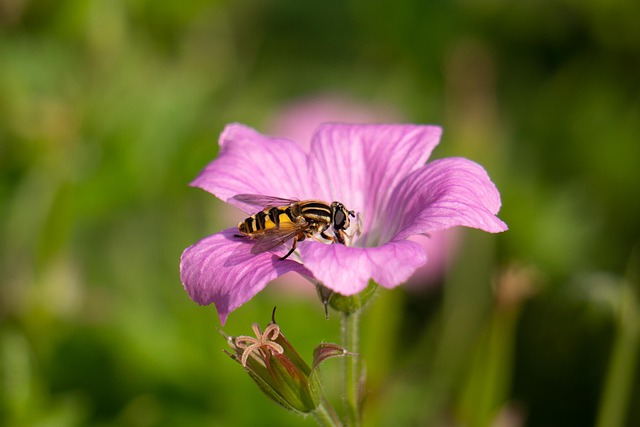
Picture: Frida Backstrom
| Latin Name | Episyrphus balteatus |
| Larval type | Maggot – mainly clear with an area of white markings. |
| Diet | Adults feed on pollen and nectar from flowers, while larvae are predators of aphids. |
| Best time to see | June to August. |
| Distribution | Patchily distributed across the UK, being seen most often in Wales and western Scotland. |
| Habitat | Marmalade flies are found wherever there are wildflowers, in habitats such as gardens, hedgerows and grassland. |
| Interesting fact: | Marmalade flies hibernate during the winter months, however they often emerge to feed on warm days and so can be seen at any time of year. |
Bees & Wasps
Red-banded Sand Wasp
The red-banded sand wasp is a black insect with a bright orange band around the front half of the abdomen. It has a narrow body and is rather large, measuring 20 mm in length.
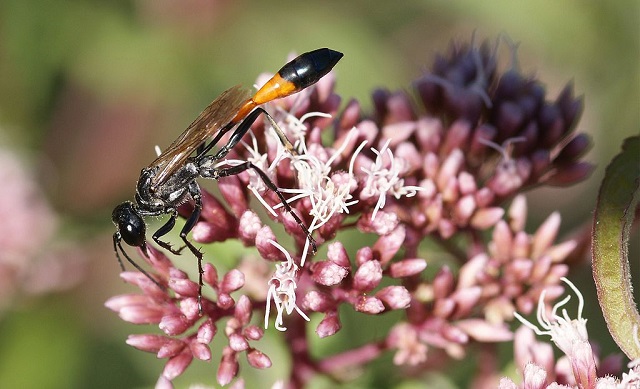
Photo: Chiswick Chap, CC BY-SA 3.0, via Wikimedia Commons
| Latin Name | Ammophila sabulosa |
| Larval type | Maggot |
| Diet | Mainly caterpillars, although other insect larvae may also be predated. |
| Best time to see | June to September. |
| Distribution | Red-banded sand wasps can be found in many parts of the UK, being most common in south-east England. |
| Habitat | Inhabits sand dunes, heathland and other sandy areas by the coast. |
| Interesting fact: | Female red-banded sand wasps paralyse caterpillars with a sting, then bury them underground in a chamber, before laying an egg. When the egg hatches, the larvae feeds on the caterpillar until ready to pupate. |
White-tailed Bumblebee
The white-tailed bumblebee has black and yellow stripes, with a prominent white tip to the abdomen. It measures 17 mm in length on average.
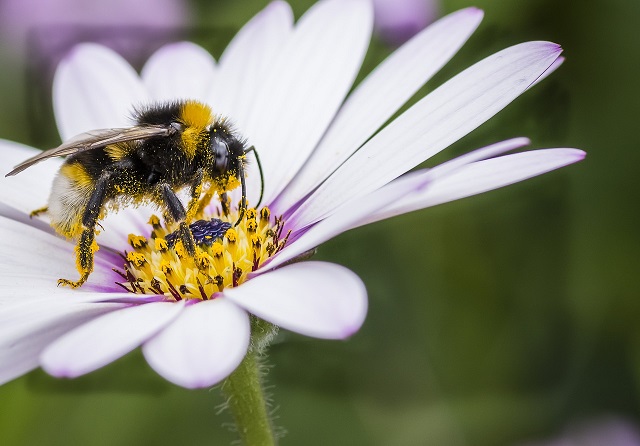
Photo: Les Whalley
| Latin Name | Bombus lucorum |
| Larval type | Maggot |
| Diet | Mainly feeds on flower nectar. |
| Best time to see | May to August. |
| Distribution | Found in many parts of the UK, but less common in Northern Ireland and central Scotland. |
| Habitat | White-tailed bumblebees can be seen anywhere near wildflowers, especially gardens, grassland and woodland. |
| Interesting fact: | The species has a shorter tongue in comparison to other bumblebees, making it harder to reach the nectar of some flowers. They overcome this by piercing holes in the backs of flowers and “stealing” the nectar this way. |
Spiders
Wasp Spider
True to their name, the wasp spider’s yellow and black stripes closely resemble those of a wasp. Females average 15 mm in length, while males are usually around 5 mm.
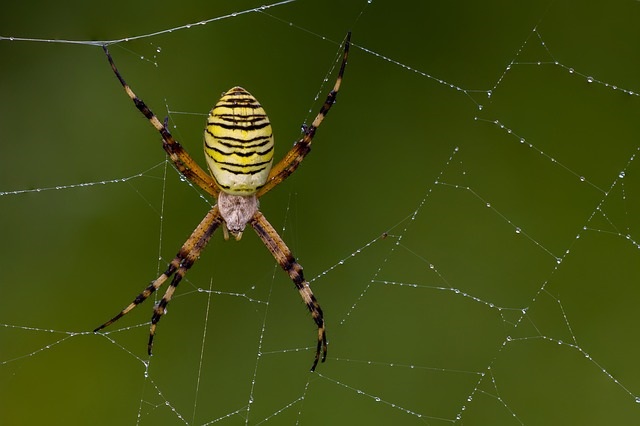
Photo: Krzysztof Niewolny
| Latin Name | Argiope bruennichi |
| Larval type | Nymph |
| Diet | Mainly insects such as flies and moths. |
| Best time to see | April to October. |
| Distribution | Wasp spiders are predominantly found in southern England. |
| Habitat | Often found in coastal areas, particularly in areas of grassland, heathland and woodland. |
| Interesting fact: | Wasp spiders weave distinct webs with zig-zag patterns. These patterns reflect UV light and help to attract flying insects. |
Woodlouse Spider
Woodlouse spiders have reddish-brown bodies, with paler abdomens. They are medium-sized spiders, measuring 13 mm in length on average.
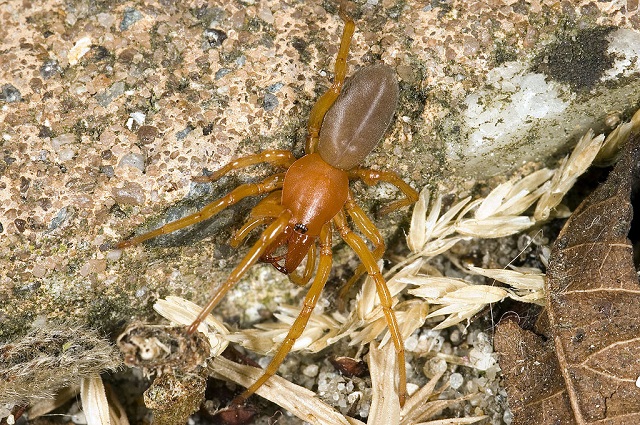
Mvuijlst at English Wikipedia, CC BY-SA 3.0, via Wikimedia Commons
| Latin Name | Dysdera crocata |
| Larval type | Nymph |
| Diet | Preys largely on woodlice, although other invertebrates will also be taken. |
| Best time to see | April to June. |
| Distribution | Woodlouse spiders are largely found in southern areas of the UK, with smaller populations in eastern England and Scotland. |
| Habitat | Warm, damp habitats such as gardens and waste ground are preferred, mainly in coastal regions. |
| Interesting fact: | Woodlouse spiders possess very large jaws, and as such are capable of killing dangerous prey such as other spiders and even centipedes. |
Zebra Spider
The zebra spider is a small spider, measuring 7 mm in length on average. Both sexes have black and white striped markings, although females tend to be darker.
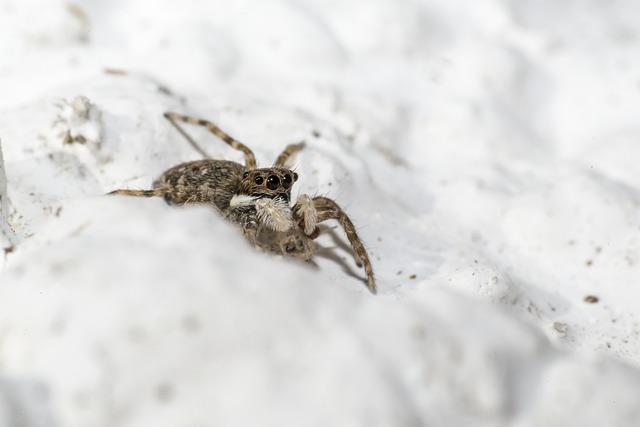
Photo: Erik Karits
| Latin Name | Salticus scenicus |
| Larval type | Nymph |
| Diet | Mainly feeds on smaller invertebrates such as flies. |
| Best time to see | April to July. |
| Distribution | Zebra spiders are very widespread in the UK and occur almost everywhere. |
| Habitat | Often found near human settlements, they can be seen in gardens or on walls and fences. |
| Interesting fact: | Zebra spiders do not construct webs, instead choosing to catch their prey by hunting. They are often seen stalking prey in a similar way to cats. |
Other Insects
Common Green Grasshopper
Common green grasshoppers are largely green, although males can appear browner than females. They have striped abdomens, and both sexes average 19 mm in length.
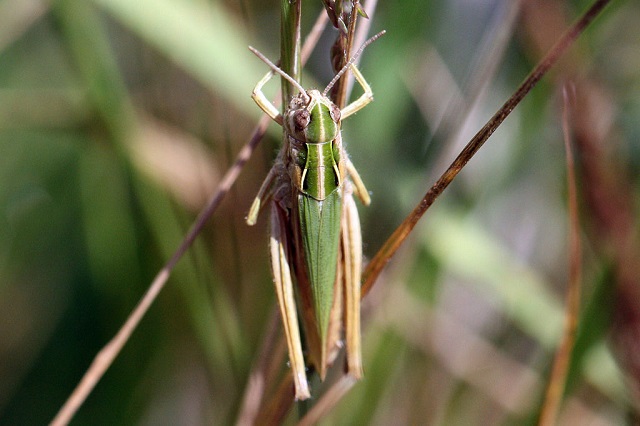
Photo: Charles J. Sharp, CC BY-SA 4.0, via Wikimedia Commons
| Latin Name | Omocestus viridulus |
| Larval type | Nymph |
| Diet | Wild grasses are their preferred food. |
| Best time to see | April to September. |
| Distribution | Common green grasshoppers are found in most regions of the UK, except for the far north of Scotland. |
| Habitat | Most often seen in grassy habitats such as meadows, parks and grassland. |
| Interesting fact: | Common green grasshoppers sing to attract a mate. The song of this species is long and loud, and sounds like a series of rapid ticking noises. |
Common Shore Bug
Common shore bugs are small beetle-like insects, measuring 4 mm in length. They are usually dark brown with light markings.

Sandy Rae, CC BY-SA 3.0, via Wikimedia Commons
| Latin Name | Saldula saltatoria |
| Larval type | Nymph |
| Diet | Feeds predominantly on smaller insects. |
| Best time to see | April to October. |
| Distribution | Common shore bugs occur in a patchy distribution across the UK, with hotspots in Wales, south-east England and northern Scotland. |
| Habitat | Mainly seen along the edges of water bodies such as ponds, streams and by the sea. |
| Interesting fact: | Common shore bugs are well-adapted to their aquatic habitats. They are light enough to land on the surface of the water, but they can also tolerate being submerged for short periods. |
Green Leaf Hopper
Green leaf hoppers are usually bright green, although they can appear turquoise in colour or even blue. They are small and squat, averaging 7 mm in length.
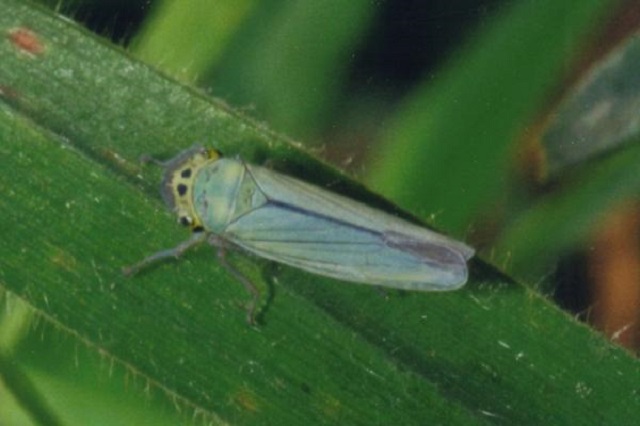
Photo: © W. Funk
| Latin Name | Cicadella viridis |
| Larval type | Nymph |
| Diet | Feeds on the sap of plants such as grass and bedstraw. |
| Best time to see | July to October. |
| Distribution | Green leaf hopper populations are scattered across the UK, with the largest found in Wales and western Scotland. |
| Habitat | Usually found in grassland, meadows and marshy areas near the coast. |
| Interesting fact: | Green leaf hoppers, like all species in the leaf hopper family, have modified hind legs that enable them to leap large distances of more than 100 times their own body length. |
Grey Bush Cricket
The grey bush cricket is grey in colour, with areas of reddish-brown around the head and neck. It has long wings and its body measures 25 mm in length on average.
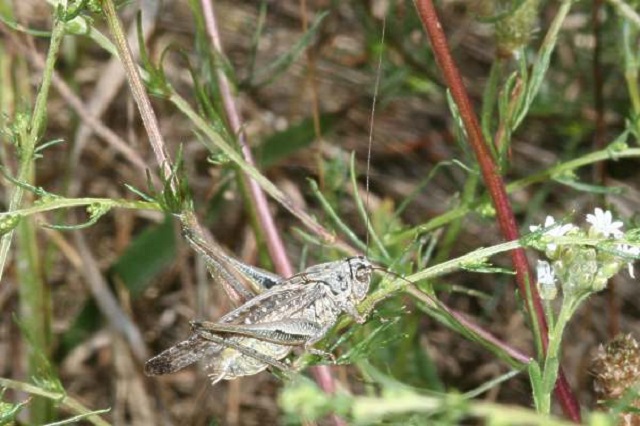 Photo: © W. Funk
Photo: © W. Funk
| Latin Name | Platycleis albopunctata |
| Larval type | Nymph |
| Diet | Feeds mainly on plant material, although smaller insects may also be eaten. |
| Best time to see | July to October. |
| Distribution | Grey bush crickets are largely restricted to the south coasts of England and Wales. |
| Habitat | Usually prefers south-facing grassland and sand dune habitats. |
| Interesting fact: | Male grey bush crickets sing by rubbing their forewings together – a process known as stridulation. This produces a chirping noise which sounds similar to a watch being wound. |
Hairy Shieldbug
Hairy shieldbugs are purplish-brown and have long hairs all over their bodies. Their antennae have white bands and their bodies measure 11 mm in length.
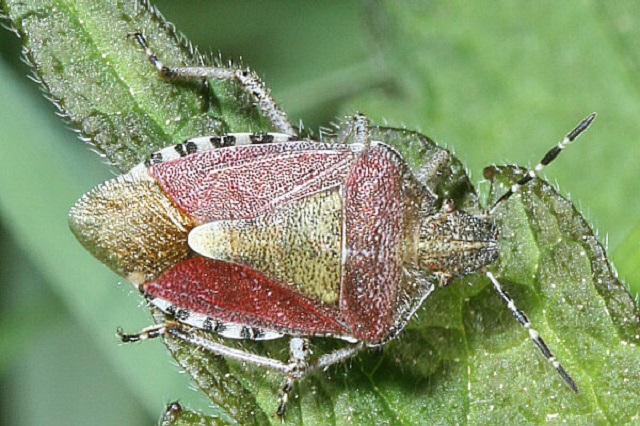 Photo: © W. Funk
Photo: © W. Funk
| Latin Name | Dolycoris baccarum |
| Larval type | Nymphs |
| Diet | Berries such as honeysuckle and raspberries make up the majority of their diet. |
| Best time to see | March to August. |
| Distribution | Hairy shieldbugs are mainly concentrated in England and Wales, with small numbers in eastern Scotland. |
| Habitat | Hedgerows and woodland edges are favoured, but they are also seen in grassland. |
| Interesting fact: | Hairy shieldbugs overwinter in leaf litter or among the dead leaves which remain on plants, before they emerge in the spring. |
Marine Bug
The marine bug is usually seen in black or dark brown colours, with bluish markings. It has a beetle-like body, large eyes and an average length of 4 mm.
| Latin Name | Chartoscirta cincta |
| Larval type | Nymph |
| Diet | Preys mainly on smaller invertebrates. |
| Best time to see | April to July. |
| Distribution | Marine bugs are mainly found in Wales and Northern Ireland, with scattered populations elsewhere. |
| Habitat | Often seen on beaches around the tideline, as well as freshwater habitats such as lakes and rivers. |
| Interesting fact: | Despite its small size, the marine bug is an agile predator and will actively hunt and kill other invertebrates that stray into its aquatic habitat. |
Pond Olive Mayfly
Pond olive mayflies are reddish-brown with a single pair of large, clear wings. They measure 6 mm in length on average.
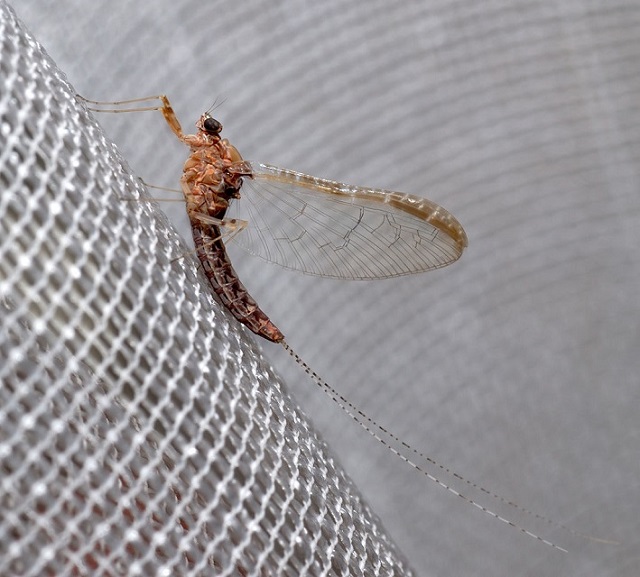
Photo: André Karwath aka Aka, CC BY-SA 2.5, via Wikimedia Commons
| Latin Name | Cloen dipterum |
| Larval type | Nymph |
| Diet | Adults do not eat, while nymphs feed mainly on aquatic algae and detritus. |
| Best time to see | May to October. |
| Distribution | Pond olive mayflies are common across the UK, although there are fewer numbers in the north of Scotland. |
| Habitat | Often seen around ponds and other small, freshwater habitats. |
| Interesting fact: | Pond olive mayfly larvae are fully aquatic and can survive for months at a time without oxygen – an adaptation that allows them to withstand ponds freezing over during winter. |
Rock Ant
The rock ant is a medium-sized ant, measuring 3 mm in length on average. Its body is sand-coloured and the antennae are kinked.
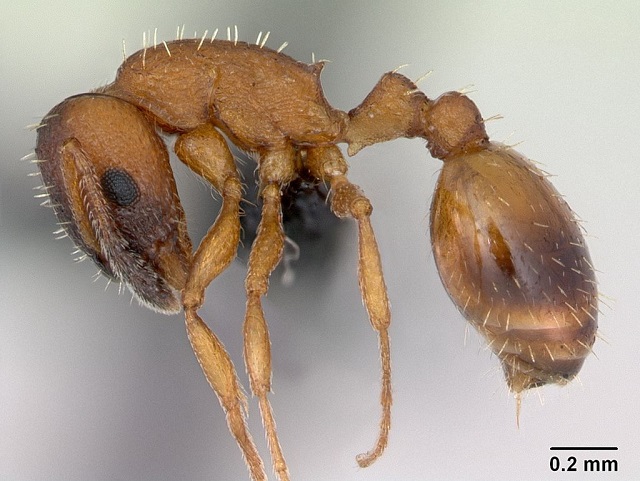
Photo: April Nobile / © AntWeb.org
| Latin Name | Temnothorax albipennis |
| Larval type | Grub |
| Diet | Mainly small invertebrates, although nectar may also be taken. |
| Best time to see | June to July. |
| Distribution | Rock ants are confined to the south coast of England and coastal regions of Wales. |
| Habitat | Usually found on warm, south facing rocky areas such as coastal cliffs and quarries. |
| Interesting fact: | Rock ants construct nests in rock crevices, which the workers surround with a protective barrier of soil particles and rock fragments. |
Yellow Meadow Ant
Yellow meadow ants are yellowish-brown in colour, with small hairs covering their bodies. They average 3 mm in length.
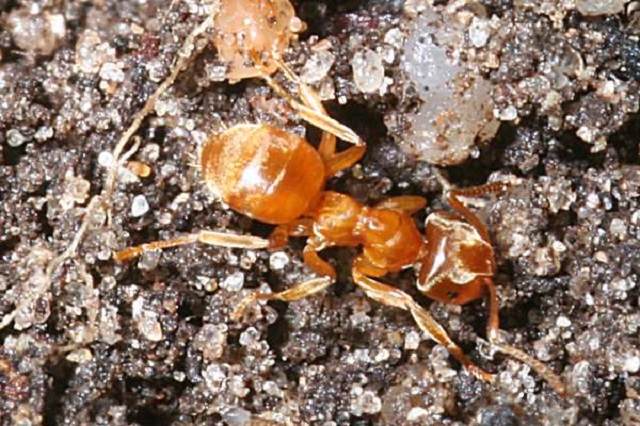 Photo: © W. Funk
Photo: © W. Funk
| Latin Name | Lasius flavus |
| Larval type | Grub |
| Diet | Feeds on honeydew produced by certain types of aphid. |
| Best time to see | June to September. |
| Distribution | Yellow meadow ants are most abundant in southern England and Wales, being less common in Northern Ireland and Scotland. |
| Habitat | Often found in areas of grassland, as well as heathland, moorland and gardens. |
| Interesting fact: | Yellow meadow ants live underground, where they ‘farm’ aphids on grass shoots and feed on the sugary honeydew they produce in return. |
Wart Biter
The wart biter is a large bush-cricket, measuring around 34 mm in length. It is usually dark green with brown patches on the wings.
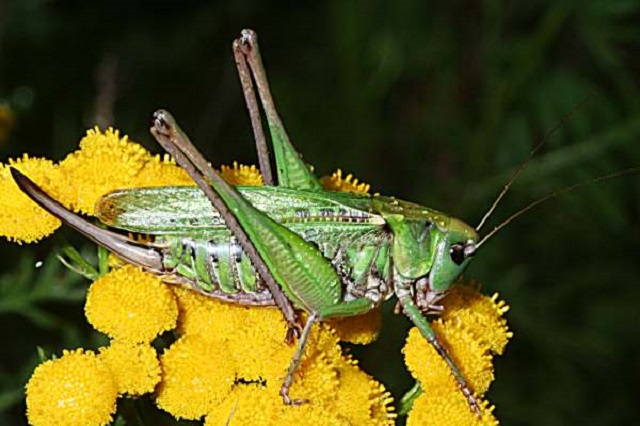 Photo: © W. Funk
Photo: © W. Funk
| Latin Name | Decticus verrucivorus |
| Larval type | Nymph |
| Diet | Their diet is omnivorous, and includes numerous plants and other insects. |
| Best time to see | July to August. |
| Distribution | Wart biters are restricted to coastal sites in southern England. |
| Habitat | Often seen on south-facing slopes, the species prefers chalk grassland and heath. |
| Interesting fact: | Wart biters have very powerful jaws, and they get their name from an old Swedish practice of allowing the crickets to bite warts from the skin. |
References
https://butterfly-conservation.org/our-work/habitat-management/coastal
https://british-dragonflies.org.uk/
https://www.bwars.com/
https://www.naturespot.org.uk/
https://www.ukbeetles.co.uk/
https://www.ukbutterflies.co.uk/
https://ukmoths.org.uk/
https://www.wildlifetrusts.org/
